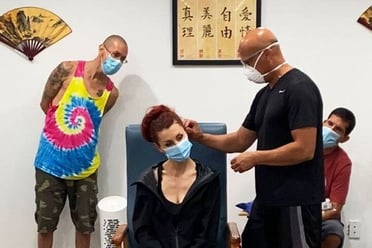AcuDetox: What you need to know

Why are people sticking needles in their ears?
It sounds kind of scary, and perhaps a little strange, but needles placed in the ears may help to alleviate stress, anxiety, and addiction withdrawal symptoms.
Initially discovered by a Hong Kong neurosurgeon over a decade ago, acudetox, or the NADA (National Acupuncture Detoxification Association) protocol, is finding a place in many addiction treatment centers and hospitals across Connecticut. In the past 3 years, we have partnered with The Connecticut Department of Mental Health and Addiction Services (DMHAS) to train over one hundred treatment providers in the NADA protocol. Similarly, Yale New Haven Hospital (SATU) has been implementing NADA groups as a part of their addiction treatment for over ten years.
Needling is provided in conjunction with conventional addiction treatment. With acudetox, unlike more traditional acupuncture, needles are placed in five specific spots in each ear. The 5 points include two known for their calming effect: the sympathetic nervous system point, and the Shen Men, or heavenly gate, believed to be the most powerful stress reducer. The other 3 correspond to organs that help the body detox: kidney, liver, and lung.
Acudetox is most often done in a group setting, with lighting dimmed to facilitate relaxation.
During a session, a trained practitioner places needles, or magnetic seeds for those uncomfortable with puncture, in each participant’s ear. The needles are left in place for 30-45 minutes while participants relax. Most are not bothered by the sting of insertion. Participants feel calm and focused at once. As the practice closes, practitioners remove the needles and document treatment effects. Physicians' orders are needed for participation in acudetox treatment in CT.
Initial research findings provided mixed evidence on the efficacy of acudetox. Several studies issued a consensus statement naming addiction as one of the methods where acupuncture was a valuable adjunct to comprehensive management programs. Recent research has more firmly documented its benefit as a detox aid. In 2017, a behavioral science study found that adding acu-detox to conventional treatment improved energy and self-esteem during treatment; most important, participants were less likely than others to be drinking alcohol in the months that followed.
I was fortunate to be able to participate in a training with Denise Romano, APRN, and Katurah Bryant, RN. The session eased my trepidation, and I was eager to give acudetox a try. As they pressed the needles into my ears, a wave of calm came over me. After 20 minutes, I did not want the treatment to end. While I was in a more relaxed state, I also felt more aware of my surroundings, and overall more mindful. Other participants in the training reported better sleep that evening, in addition to feeling more relaxed and less stressed. Having worked for a few decades in mental health, I immediately thought that this would be a wonderful tool to use with more difficult to engage clients. I felt optimistic and enthusiastic about this treatment.

With the opioid addiction crisis worsening, we are fortunate that our state recognizes the benefits and effectiveness of acudetox by providing it across our behavioral health system. So next time you see someone with needles in their ears, please know they are helping themselves to recover and heal.
Subscribe for updates
_.webp)



